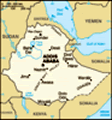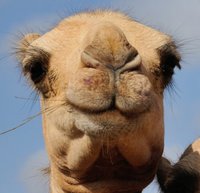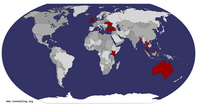COMING SOON HOUSE ADVERTISING ads_leader
Even though the first half of my journey to the Omo Valley introduced me to vastly different cultures, the second half would see me meet some truly extraordinary tribes. The next destination was a village called Kolcho inhabited by the Karo tribe who are renowned for their body painting. Our vehicle encountered the roughest dirt road conditions so far, and we occasionally needed to navigate around huge holes and carefully negotiate near vertical drops into dry river beds – Tsegaye’s driving was superb.
After much jarring of bones, we arrived at Kolcho nestled near to a stunning lookout with a magnificent panorama over the Omo River. This was one village worthy of an entrance fee, for not only were the views impressive, but so too was the village. Covering a large area with a multitude of huts, it was a tremendous place to explore, and I spent half a day in this locale.
Along with the Hamer tribe, the Karo people are the most pleasant, it was possible to walk around unaccompanied and receive only occasional, polite requests for photographs. In this village with neither electricity nor water supply, I was allowed to quietly glance at Karo life; women
would grind grains for dinner and larger children would play with their younger and smaller siblings by sitting them on a large piece of metal and drag them along at speed. It was an idyllic scene of simple and unaffected contentment.
The Karo people deserved their title as the region’s best body painters as they sported elaborate and full decorations but the reason for this artistry was never fully explained to me, apart from the obvious atheistic and decorative aspects. This was also my first exposure to a village where men carrying guns was the norm, so if one was nervous around weapons, this was not the place to be. Apart from one woman who spoke to me in perfect English (what a shock that was) the rest of my communication was conducted by gesturing, and it is heartening to know that genuine warmth can be established between people from extremely different cultures and different languages within a brief time frame.
The only town of note in the Omo Valley is Jinka – it even has mobile phone coverage. Rambling past the cattle grazing on the uneven dirt streets one late afternoon, many friendly people approached me who
keenly wished to talk and swap stories. When the sunset’s scarlet light painted the buildings with its soft hue, I returned to my room where I saw my reflection in a mirror for the first time in many days and was surprised at my gaunt appearance. Subconsciously I had reacted to the average state of the food and the worse state of the toilets by eating little, thus allowing me to minimise my exposure to both. This approach and my post-Yemen illness had combined to see me lose ten percent of my weight.
The final tribe was the most famous and feared in the Omo Valley; the aggressiveness of the Mursi is known by any visitor here, and I have heard of other travellers unwilling to visit them due to episodes such as stone throwing and their predilection for alcohol. However, they also promised an unforgettable experience, so undaunted our vehicle proceeded to the Mago National Park where the tribe resides. A sign at the park’s entrance states: “No Automatic Weapons”, but this regulation is flagrantly ignored by the Mursi.
At the final checkpoint we were required to acquire the services of an armed guard, and whilst organising

 Karo warrior - Kolcho, Omo Valley, Ethiopia
Karo warrior - Kolcho, Omo Valley, Ethiopia
We established a real bond in the short time I was in the village.this service, we met a departing group who had stayed with the Mursi the previous night, who reported the evening as “difficult” with “very little sleep”. We continued our journey and encountered another small potential peril. Apart from the Omo Valley’s malarial mosquitoes this area is home to the Tsetse Fly, and when one of these brightly coloured insects appeared in the car, the guard became most agitated when it approached him too closely. An agitated armed guard is never a good situation regardless of the cause.
We reached our destination to scenes of frenzied activity as two vehicles with a dozen tourists had already arrived, and the Mursi were swarming around them like a pack of sharks closing in for a kill. Women were particularly aggressive in physically seizing you for a photo and the prices asked for photographs (4 Birr or 30 cents) were sometime double the usual amount. This was more confrontational than the Arbore tribe, and in order to manage this situation it was thought best to withdraw until the other tourists had departed in the hope that the villagers would be calmer with fewer foreigners to target. Thankfully, this prediction proved correct, and I
was subjected to comparatively less hassle once they returned to their usual daily activities.
Communicating with the tribe was protracted as conversations needed to be translated from Mursi to Amharic and from Amharic into English; so these stilted colloquies involved not only the Mursi and me, but two interpreters as well. Automatic weapons were ubiquitous, and this was the only tribe where women also carried weapons, a practice considered abhorrent by other tribes. The reason for this convention was difficult to determine, it was either deemed necessary for protection against predators, but more likely it was for protection against other Mursi.
The body decoration on the Mursi was superb, and the scarification used by both men and women tended towards the elaborate. However, the iconic image of the Omo Valley is that of the lip plate worn only by the women, and they vary in size from moderately small to more than 20 centimetres wide. This adornment is not universally utilised, but the women who chose to do so consider it an object of beauty. The plate, which has a groove around the edge where the extended lip is placed, is not worn continuously as the wearer will
remove it when eating or sleeping. The plates are also left home when visiting the Jinka markets as the Mursi believe that these plates appear odd to outsiders, which is true enough. Despite this, plate wearing is preferable to seeing a stretched lip loosely hanging beneath the chin due to it not being wrapped around its plate.
We departed 90 minutes later, but I was disappointed by my poor reaction to the Mursi’s aggressiveness that allowed me to be overwhelmed for a second time on this journey, and the poor creativity of my photographs reflected this. I indicated my wish to alter the itinerary and return the following morning, and the only other foreigner in the vehicle (an exceptional photographer named Musa) and I engaged in various discussions; I was initially most enthused about returning, but Musa and Tsegaye less so. However, when I faltered in advocating for another attempt, it was Musa who provided the impetus. So with a greater mental preparedness, we returned to visit two different Mursi villages, both were smaller, the frenzy less, and the more relaxed mood allowed me to capture better photographs whilst sharing a laugh with the locals. It was a pleasant

 Instense gaze of Karo woman - Kolcho, Omo Valley, Ethiopia
Instense gaze of Karo woman - Kolcho, Omo Valley, Ethiopia
She the only tribal person in the Omo Valley I met who spoke with such clearly enunciated English.way to conclude my tribal visits.
We departed for the three day journey to Addis Ababa and it allowed me to reflect on the oft described vanishing tribes of the Omo Valley. These tribes as so distinct that one could determine tribal origins by merely looking at clothing and body adornments, but how do these tribes retain this distinctness? Tourism’s negative impact is the obvious demand for photographic payments and I had become part of the problem by ceding to such. Visiting tribes where people would stand in line hoping to be a photographic subject was most uncomfortable for all concerned.
However, tourism which can often destroy can also preserve. The Omo Valley seems to retain its culture better than many places; it compares favourably to my experiences at the remote Siwa Oasis in Egypt where I heard the music of Bob Marley emanating from an “authentic” restaurant, and in Jaisalmer, India where I witnessed musicians dressed in traditional Rajasthani clothes playing
Frère Jacques. Both of these were clear attempts to pander to foreigners with music of no relevance to the local culture. At least the Omo Valley tribes realise that their traditional lifestyle and culture provides an
income, and it is this income that encourages them to maintain their identity, even if it is at the cost of avarice.
The Omo Valley is a most incredible destination, and Ethiopia, much like the rest of Africa, is a place where the people, their culture, and landscape all seep into your soul. Our final Omo Valley stop was at Key Afar where a young man approached me selling jewellery. I purchased a simple brass ring, and as a symbolic gesture I placed it on my ring finger as a sign of betrothal to this continent; for wherever in the world I may be, a part of me will always remain in Africa.
COMING SOON HOUSE ADVERTISING ads_leader_blog_bottom
Tot: 0.072s; Tpl: 0.026s; cc: 16; qc: 27; dbt: 0.0305s; 1; m:domysql w:travelblog (10.17.0.13); sld: 1;
; mem: 1.2mb







































Jo Trouble
Jo McCarthy
Amazing!
More amazing photos and stories - well done Shane! That first photo in particularly says plenty about both contrasts and similarities. And good to know that the Omo Valley is retaining its character, always a shame when tourism turns out to be too much of a good thing. One of the best entries I've seen all year - congratulations!